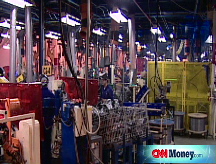GM's $35 billion albatross
GM needs to prove to the government that it will be able to cut unsecured debt by two-thirds. Some think creditors have no choice but to accept a swap for stock.
NEW YORK (CNNMoney.com) -- General Motors has many woes, from weak sales and expensive labor contracts to a lineup of vehicles that includes more misses than hits.
But if GM hopes to have any chance to fix any of these problems, it will first have to figure out how to get out from under about $24 billion in debt it can no longer afford.
That's the amount of debt that GM (GM, Fortune 500) needs to shed in the coming weeks.
The company has to present a viability plan to the Treasury Department as part of the terms of the federal bailout that is keeping it afloat. As part of that plan, GM is required to reduce its $35 billion in unsecured debt by two-thirds.
GM has to show how much progress it has made in negotiations with creditors by Feb. 17, and must have agreements in place by the end of March. Otherwise, GM could be forced to repay up to $13.4 billion in federal loans it has used to avoid filing for bankruptcy.
GM ran up most of its huge pile of debt before the company was downgraded to junk bond status in 2005. Relatively little of the debt came from the $18 billion in operating losses that GM's automaking operations have posted since then.
"The cash they've been burning through is cash they raised selling a stake in GMAC and other asset sales along the ways, not new borrowing," said Bob Schulz, Standard & Poor's senior auto credit analyst.
Roughly half the debt came from the company's decision in 2003 to borrow $14.5 billion in order to cover a gap in its pension funds. That roughly doubled the amount of unsecured debt outstanding at that time.
The bond market is clearly anticipating that the current creditors will have to take a deep haircut on their GM bonds. Shelly Lombard, an analyst with independent debt research firm Gimme Credit, says GM debt is now trading at about 14 cents on the dollar. That's down from about 20 cents on the dollar at the end of December, shortly after GM received the federal bailout.
Lombard said the threat that GM would be forced into bankruptcy without a renegotiation of debt gives current creditors little leverage -- which means they may be forced to accept some kind of debt-for-stock swap.
"This company is on a respirator," she said. "The bondholders can't afford it to slip off the respirator and go into Chapter 11."
Lombard and Schulz both say that GM's mountain of debt, which costs the company about $3 billion in interest payments annually, did not bring on the cash crisis that nearly toppled GM late last year. But it was still a big problem.
"When leverage really hurts you is in a downturn like this," said Lombard. "It gives a company a lot less flexibility and a lot less ability to compete."
But both Lombard and Schulz say the debt load wasn't considered the most pressing concern for the company until it became part of the legislative debate about federal help for the industry.
Sen. Bob Corker, R-Tenn., an influential critic of the bailout proposal, argued last month that Congress shouldn't give taxpayer dollars to the auto companies unless they had a more affordable debt structure that would increase the chances of the federal loans being paid back.
Meanwhile, United Auto Workers union president Ron Gettelfinger said at the time that the union was willing to give the automakers additional cost savings in their labor agreements as long as creditors also made sacrifices.
GM's rivals do not face the same debt reduction requirements. Chrysler LLC, which got $4 billion in federal loans, has little unsecured debt, the only kind the bailout is requiring be reduced. Ford Motor (F, Fortune 500) has yet to receive federal assistance that would trigger a debt-reduction requirement.
Both companies are believed to be holding their own negotiations with creditors so that GM does not gain a competitive advantage if it is able to successfully reduce its debt.
It's not clear how difficult it will be for GM to win the changes it is seeking from bondholders. A similar equity-for-debt offer by its GMAC finance arm had to be revised numerous times in December before finally winning enough support.
GM says it is only in the early stages of negotiations with its bondholders. But during the Senate debate on the auto bailout Dec. 11, Corker said he thought bondholders were on board with the demand to reduce debt by two-thirds in return for stock.
A call seeking comment from the New York law firm advising the bondholders' committee was not returned.
Some critics of the auto bailout argue that it would be foolish for the creditors to accept a debt-for-equity swap unless GM is able to win more substantial changes in the labor cost structure than currently being negotiated -- even if the alternative is a bankruptcy filing.
While the holdings of unsecured creditors would be wiped out in a bankruptcy, they could still get equity in a restructured company if it survives the bankruptcy process.
"The bondholders would be better off going through Chapter 11 now than three years from now if GM can't get a real labor contract," said Peter Morici, a business professor at the University of Maryland.
But supporters of the bailout argue that GM is making enough progress in cutting costs and is well positioned to be very profitable once the current sales slump ends. So a swap for stock could turn out to be a good deal for creditors.
"When you have such depressed value on the bonds that you do right now, the potential to participate on the upside with equity is pretty good," said David Cole, chairman of the Center for Automotive Research, a Michigan-based think tank. ![]()



